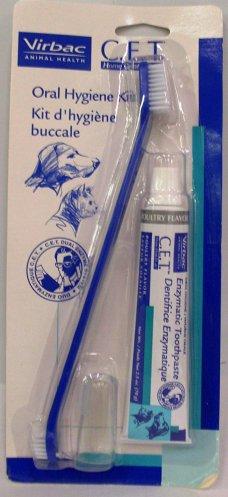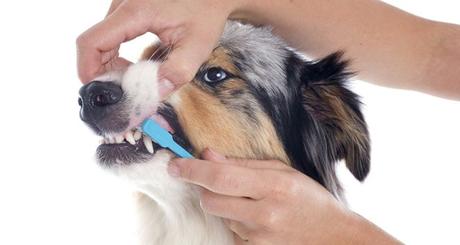The main function of the mouth and teeth is to soften food and prepare it for digestion. The anatomy o the mouth is the key difference between the dog and its ancestor - the wolf. Dogs have more crowded teeth than wolves, and in many breeds the teeth have become even closer together. This made dogs more prone to tooth and mouth problems. Additionally, the incidence of teeth problems has risen because dogs no longer use their mouths to catch and tear apart prey.

How to carying for your dog's teeth health? Source
The dog has a classic carnivore's mouth. It has small incisors ideal or nibbling and scraping meat from bones and for grooming. Its long canines are built for seizing prey and tearing meat. The premolars and molars hold, shear and cut meat and grind plants. The dog's teeth have much deeper roots than we humans do. In fact its roots are longer than the teeth themselves.
A healthy mouth is vital for good general health. Substances in the saliva act as natural antiseptics, reducing the risk of infection, while the physical action of tearing and chewing food massages and cleans the gums. The teeth should be well spaced, so they do not trap debris. If they are crowded, as in smaller and flat-faced breeds, the plaque is more likely to accumulate, thus leading to possible gum infections. Gum infections are not only painful and debilitating, but can also be a source of bacteria that travel to other parts of the body, via the bloodstream.
Mouth and tooth problems are one of the most common conditions that require veterinary attention. Signs that your dog has dental problems include:
- Halitosis (bad breath)
- Broken, loose, discolored, misaligned and missing teeth
- Reluctance to eat
- Slow eating
- Eating with tilted head
- Gagging
- Yellowish-brown tartar buildup
- Pawing at its mouth
- Excessive drooling
- Chattering the teeth
- Difficulty swallowing
- Bleeding, swollen or red gums
- Unusual growths inside the mouth.
The most efficient way to maintain good oral hygiene is to brush your dog's teeth and gums routinely. In the past it was considered that just brushing is enough for keeping your dog's dental hygiene on a satisfying level. Today it is scientifically proven and well understood that brushing, without using toothpaste, is almost the same as not brushing at all. In a nutshell, if you want to keep your dog's mouth clean and healthy, you have to use both canine toothbrush and canine toothpaste.

It is important to never use human toothpastes for dogs. Human toothpastes contain a plethora of non-edible substances that dogs cannot properly metabolize. These substances can be harmful and toxic to your dog.
Dog toothpastes come is special flavors like vanilla, poultry, beef, mint and peanut. However, the ideal dog toothpaste goes beyond being safe and tasty. It should:
- Change the pH of the dog's mouth, thus making it a hostile place for microorganism growth
- Prevent the food debris from gluing itself on the teeth surface and forming plaque
- Have antibacterial powers that kill the bacteria responsible for turning the sticky plaque into hard tartar
- Improve the overall gum health and prevent tooth decay, as well as periodontal disease
- Get rid of bad breath
- Have a lingering effect that lasts a long time after the brushing has finished.
It should also be noted that human toothbrushes are not best suited for dogs. This is because human toothbrushes:
- Do not have angled heads
- Have bristles that are either too sharp or too firm.
A good dog toothbrush features an angled head and soft, but firmly rooted bristles. The angled head makes it easier to clean all hard-to-reach places. The bristles need to be firmly rooted in order to avoid their dislodging and sticking between teeth. Popular dog toothbrushes include:
- The single head brush
- The multiple-head brush
- The finger brush.
With that being said, it is time to discuss perhaps the hardest part of your dog's oral hygiene. That is training your dog to let you brush its teeth. The best way to train your dog is to start while young.

You can start by putting your fingers inside its mouth so it can get used to the idea of having something other than food. Then start using a small toothbrush. Begin by brushing for few seconds at a time. At first you do not even need to brush, it is enough to just put the brush in your dog's mouth and rotate it around the oral cavity. As the dog gets used, you can gradually increase the brushing time. It is advised to always give food rewards after completing the brushing ritual. That way your dog can easily link the brushing with some positive experience.
Luckily, dental health problems can be easily prevented. All you need is a canine toothbrush, a canine tooth paste and a little strategy. In a nutshell, if you want your dog's mouth to be clean and healthy, you need to:
- Have your dog regularly examined by a licensed veterinarian
- Get your dog's teeth professionally cleaned at least once a year
- Brush your dog's teeth regularly, preferably every day. Recent studies suggest that brushing less than 3 times a week has the same effect as no brushing at all. Therefore it is recommended to brush the teeth at least every other day.

